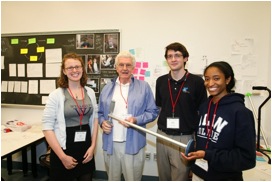A course for the three-college community.
Spring Semester 2014: Mondays 10:50 am - 1 pm and Wednesdays 2-5 pm
Do you want to make a positive difference in the lives of older adults in the local community? We’re looking for students with passion to help others and with diverse backgrounds in arts, humanities, social sciences, business, and/or technical fields. This innovative, intergenerational course is a partnership between college students and local senior citizens. It is co-taught by two Olin College professors with experience in anthropology, design, and computer science, and will take place at Olin College and in local communities (home visits and fieldtrips). We will partner Wellesley-Babson-Olin student teams with local senior citizen volunteers, and ultimately the students will design real, implemented solutions to specific everyday problems.
Projects will be customized to meet the needs of the senior citizen partners. Possible projects: students might design a device to help someone who has difficulty reaching up to change a light bulb, something to help hold a newspaper steady with shaky hands, or something to enable someone to get clothes out of a dryer that is difficult to stoop down to reach. The class meets 2x/week; some sessions are devoted to co-design with the client population or to team meetings, other sessions involve guest speakers and fieldtrips, others are for discussion of topics relevant to aging and/or design. No prerequisites; a sense of adventure highly recommended.
This course is suitable for students without prior engineering coursework and available for Babson and Wellesley students. The course will be taught seamlessly (2cr ENGR and 2cr AHS) with integrated activities and topics ranging from anthropology/sociology to design/build.

Photo and video of the “Stand Aid” team and other projects from the spring 2011 class. The team built this device to help their class volunteer get out of a car more easily. The device was intended to be easy to use and easily accessible from the driver’s seat. More press coverage.
For more information, contact Professors Caitrin Lynch and Ela Ben-Ur